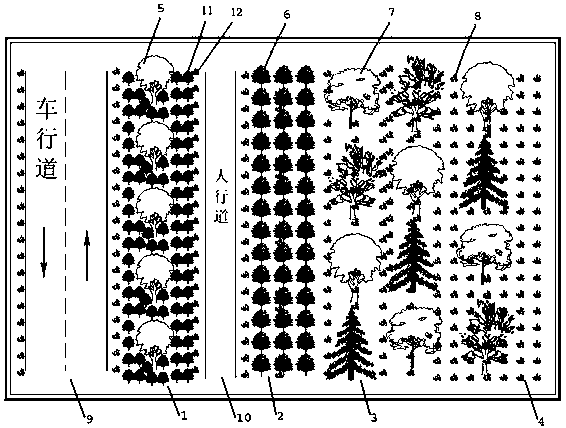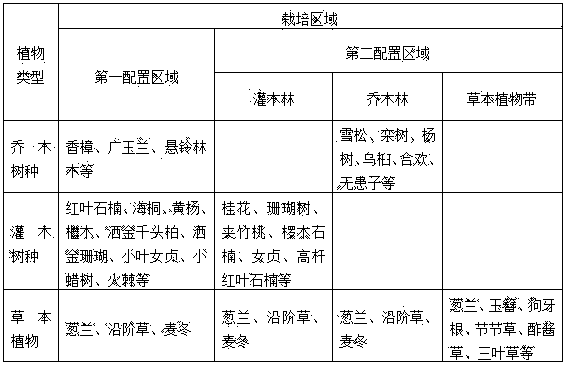Allocation method of belt-shaped three-dimensional mixed noise reducing type urban forest
A configuration method, noise-reduction technology, applied in forestry, application, agriculture, etc., can solve problems such as unprotected space, construction cost, and high maintenance cost
- Summary
- Abstract
- Description
- Claims
- Application Information
AI Technical Summary
Problems solved by technology
Method used
Image
Examples
Embodiment 1
[0040] Such as figure 1 As shown, a strip-shaped three-dimensional hybrid noise-reduction urban forest configuration method is as follows:
[0041] (1) Select the first evergreen tree 5, the second tree 7, the dwarf shrub 11, the tall shrub 6, the first herb 12, and the second herb 8 that are luxuriant and fast-growing; the first arbor 5 1. The height of the second tree 7 is not less than 7m, the height of the dwarf shrub 11 and the tall shrub 6 is not less than 2m, and the height of the first herb 12 and the second herb 8 is not less than 20cm.
[0042] (2) Plant a row of first arbors 5 along the direction of the roadway on the outer side of the roadway 9, and densely plant dwarf shrubs 11 around the first arbor 5, and then densely plant them on both sides along the roadway and sidewalk There are first herbaceous plants 11, forming a first configuration area 1, and the width of the first configuration area 1 is 1.2-1.5 m.
[0043] (3) Rows of tall shrubs 6 , second trees 7 ...
Embodiment 2
[0054] Take the urban forest configuration method on Xiangzhang Avenue in Shufengwan Sports Park, Hefei City, Anhui Province as an example.
[0055] Among them, the main trees are camphor, privet and acacia, the main shrubs are sweet-scented osmanthus and heather, and the main herbaceous plants are green onion, Ophiopogon japonicus and albizia.
[0056] The forest belt is mainly composed of four rows from the roadway to the noise-sensitive target direction:
[0057] The first row is located between the roadway and the sidewalk: it is composed of camphor + phoenix + onion orchid, and the plant spacing of camphor is 2 m. Plant 1-2 rows on the side; form the upper, middle and lower layers of vertical canopy forest belts, and gradually attenuate the roadway through their "blocking-absorbing-reflecting-blocking-reabsorbing-rereflecting" noise.
[0058] The second row is located on the outside of the sidewalk away from the roadway: it is densely planted with osmanthus flowers abou...
Embodiment 3
[0064] Take the urban forest allocation method on the south side of Changjiang West Road, east of the intersection of Changjiang West Road and Yulan Avenue in Hefei City, as an example to illustrate.
[0065] Among them, the main trees are plane tree, Huangshan eucalyptus, Albizia juniperus and poplar, the main shrubs are tall phoenix phoenix, and the main herbaceous plants are Ophiopogon japonicus, step grass and clover.
[0066] The forest belt is mainly composed of four rows from the roadway to the noise-sensitive target direction:
[0067] The first row is located between the roadway and the sidewalk: it is composed of syringa + privet + Ophiopogon japonicus, the distance between the plants of sycamore is 2 m; Plant 1-2 rows at the side; form the upper, middle and lower layers of vertical closed forest belts, and gradually attenuate the roadway through their "blocking-absorbing-reflecting-blocking-reabsorbing-rereflecting" noise.
[0068] The second row is located on the...
PUM
 Login to View More
Login to View More Abstract
Description
Claims
Application Information
 Login to View More
Login to View More - R&D
- Intellectual Property
- Life Sciences
- Materials
- Tech Scout
- Unparalleled Data Quality
- Higher Quality Content
- 60% Fewer Hallucinations
Browse by: Latest US Patents, China's latest patents, Technical Efficacy Thesaurus, Application Domain, Technology Topic, Popular Technical Reports.
© 2025 PatSnap. All rights reserved.Legal|Privacy policy|Modern Slavery Act Transparency Statement|Sitemap|About US| Contact US: help@patsnap.com



